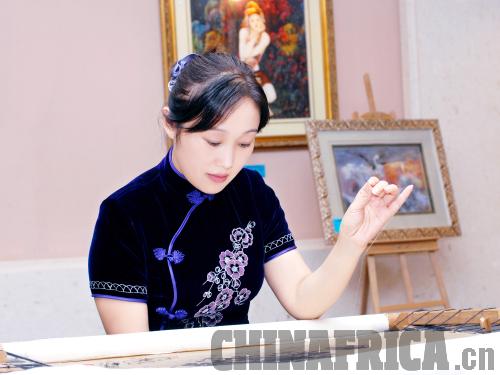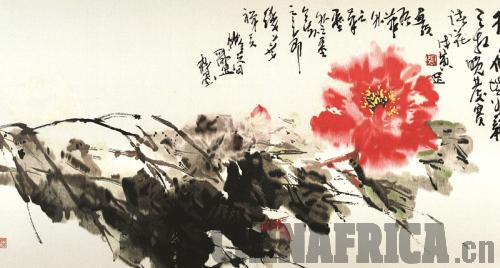| 
Yao Huifen stitching

Embroidery artwork Peony
When Suzhou Embroidery (or Su Xiu in pinyin), one of the four major Chinese embroidery styles, from east China, was listed as a national intangible cultural heritage in 2006, Yao Huifen, a renowned master of the art, had no idea what that would mean for them, she recalled. She has witnessed a milestone move to protect China's precious treasures: its traditional art and culture.
To celebrate the 70th anniversary of the United Nations Educational, Scientific and Cultural Organization (UNESCO), the first Qianmen International Intangible Cultural Heritage Forum was held in Beijing on July 27. The forum ended with the launch of an intangible cultural heritage expo park at the 600-year-old iconic Qianmen Street. The nearly 400,000-square-meter park, which is scheduled to be partially ready by October, will see intangible cultural heritage masters from across the country open their businesses here. Yao and nearly 300 other masters, including Cloisonne master Zhang Tonglu, Thangka master Niang Ben and Nantong Blue Calico master Wu Yuanxin, have agreed to do so, hoping it would provide them better opportunities at a time when their arts are facing stiff challenges.
Born into a family in Suzhou, Jiangsu Province, that had been doing Su Xiu for generations, Yao started to learn the art as a young girl.
With 30 years' practice, today Yao is proficient in various stitches and thoroughly understands the true essence of Su Xiu. Her work has become unique and modern, combining the silk embroidery with traditional Chinese wash painting and Western oil painting. Yao has opened a workshop in Suzhou to promote the art and let more people, especially the young people, aware of this unique culture and learn the skill.
Compared to the other three major styles - Hunan Embroidery (Xiang Xiu), Sichuan Embroidery (Shu Xiu) and Guangdong Embroidery (Yue Xiu), Su Xiu is characterized by subtle and refined needlework. "It is praised for its use of the finest threads and dense yet smooth stitches," Yao said.
The art has a 2,500-year-old history. Yao is especially skilled at random embroidery, a way which combines Western oil painting and portraiture. With lines of different colored threads and varying layers, it is a very vivid and expressive art form.
Inheritance predicaments
Modernization and industrialization tend to have an adverse impact on traditional handicrafts, which face steep competition from machine-made goods that take less time to manufacture and are far cheaper. Su Xiu is no exception. Then there is the dearth of skilled practitioners.
"The embroiders are ageing," Yao said, adding that most Su Xiu embroiders are middle-aged women. But the embroidery is an art that takes decades to master. From designing and stitching to mounting and framing, a single piece of embroidery usually takes months. As a result, few young people are willing to devote their whole life to learning a traditional handicraft.
Then there are the problems of quality and market demand. The embroidery was originally meant for daily use. However, their current market prices are so high that they are regarded more as artwork than daily-use items. Yao and other embroiders want to return their products to essentials which would be affordable for every family.
Originality of embroidery work is also an issue. The typical patterns include birds, cats, plants, natural scenes and ancient Chinese paintings. That makes it easier for embroiders to imitate one another and therefore the works lack innovation. Yao is hoping the designs can incorporate modern themes reflecting the tastes of the time.
She has great expectations of the Qianmen expo park. She points out that in recent years, national intangible cultural heritage has received strong support from the central and local governments. The Qianmen expo park is a new venture supported by the Chinese Intangible Cultural Heritages Protection Association. Yao hopes this platform will help more outsiders beyond her hometown become aware of Su Xiu. She plans to explore developing this intangible culture heritage further with other inheritors.
Offline to online presence
China is one of the earliest countries to join the UNESCO Convention for the Safeguarding of the Intangible Cultural Heritage. In order to protect national intangible cultural heritage, the Central Government authorized an intangible cultural heritage division in the Ministry of Culture and made a law to preserve intangible cultural heritage.
Wang Wenzhang, President of China Art Research Institute, also has high expectations for the Qianmen expo park. He advocates "productive protection," which seeks greater productivity and market for intangible cultural heritages while conforming to the rule of its own growth. The Qianmen expo park provides new opportunities for intangible cultural heritage to follow a new business model.
"The core of intangible cultural heritage protection is inheritance," Wang said. "We need to find ways for this. Making the traditional handicrafts more market accessible is a better way for their inheritance as they will become more popular."
Along with the expo park, e-feiyi, an intangible cultural heritage e-business platform, was also launched at the forum, with the aim to popularize and market intangible cultural heritage products. It is a platform for both inheritors and enterprises, as well as consumers. This platform will provide another option for buyers who love traditional handicrafts as e-commerce has been booming. Through this platform, consumers can easily get whatever they want no matter where they are.
"I think it is interesting to combine both online and offline platforms to promote Su Xiu," Yao said with a satisfied smile. "More people will know about this art in this way." |